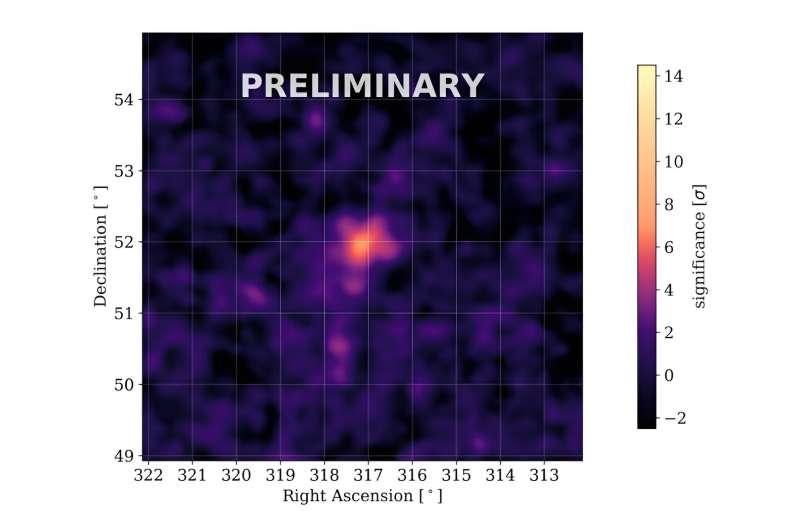September 11, 2023 report
This article has been reviewed according to Science X's editorial process and policies. Editors have highlighted the following attributes while ensuring the content's credibility:
fact-checked
preprint
trusted source
proofread
Mysterious ultra-high energy source investigated by astronomers

Astronomers from the University of Maryland and the Michigan Technological University, have inspected a mysterious ultra-high energy gamma-ray source known as LHAASO J2108+5157. Results of the study, published August 31 on the pre-print server arXiv, could help us unveil the true nature of this source.
Sources emitting gamma radiation with photon energies between 100 GeV and 100 TeV are called very-high energy (VHE) gamma-ray sources, while those with photon energies above 0.1 PeV are known as ultra-high energy (UHE) gamma-ray sources. The nature of these sources is still not well understood; therefore, astronomers are constantly searching for new objects of this type to characterize them, which could shed more light on their properties in general.
A team of astronomers led by University of Maryland's Sajan Kumar decided to take a closer look at one such UHE gamma-ray source designated LHAASO J2108+5157. It is a point-like source with an extension less than 0.39 degrees, known to be associated with the molecular cloud [MML2017]4607—located some 10,700 light years away.
Previous observation of LHAASO J2108+5157 detected no X-ray counterparts and it turned out that the closest X-ray source is the eclipsing binary RX J2107.3+5202 with the separation of about 0.3 degrees. Given that no powerful pulsars or supernova remnants have been detected so far in the vicinity of LHAASO J2108+5157, it is difficult to determine the origin of its gamma-ray emission as it can be explained either by hadronic and leptonic models.
Therefore, Kumar's team observed LHAASO J2108+5157 with the Very Energetic Radiation Imaging Telescope Array System (VERITAS) and the High-Altitude Water Cherenkov Observatory (HAWC) in order to shed more light on the emitted UHE gamma-rays.
The observations found no significant emission close to the position of LHAASO J2108+5158. The astronomers also performed spectral analysis on the circular region with the radius of 0.09 degrees around the position of LHAASO J2108+5157, measuring differential flux upper limits at 1.0, 3.98, and 15.38 TeV energy—consistent with previous studies.
The obtained upper limits exclude the hadronic model and suggest a leptonic origin of emission from few TeV to hundreds of TeV energy. However, the researchers noted that a new molecular cloud has been recently identified in the vicinity of LHAASO J2108+5157, what sheds more light on the origin of the observed gamma-ray emission.
"The morphology of this new cloud highly correlates with the LHAASO J2108+5157 gamma-ray emission up to 2 GeV from Fermi-LAT and emission detected by LHAASO. This makes it more likely that the gamma rays are produced through the hadronic channel with molecular cloud as the main target for the cosmic ray particles accelerated by unidentified PeVatrons," the astronomers concluded.
They added that future observations by CTA and analysis in the X-ray band are required in order to fully understand the nature of LHAASO J2108+5157.
More information: Sajan Kumar et al, VERITAS and HAWC observations of unidentified source LHAASO J2108+5157, arXiv (2023). DOI: 10.48550/arxiv.2309.00089
Journal information: arXiv
© 2023 Science X Network



















